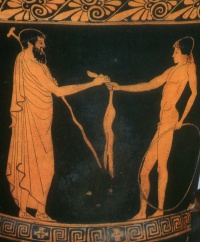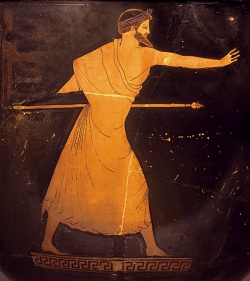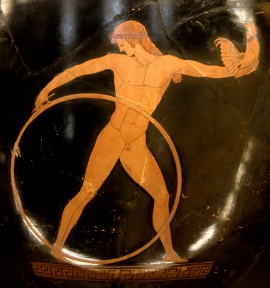Hoop rolling (ancient Greece)

Man presents a leg of mutton to a youth with a hoop, in an allusion to boylove.[1] Athenian red-figure vase, ca. 460 BC
The hoop held symbolic meanings in Greek myth and culture and was used to represent a boy or youth in general in Greek art. The Greeks referred to the hoop as the trochus or krikoi, and they were probably made of bronze, iron, or copper. They were driven with a stick called the elater.[2] A bronze hoop was one of the toys of the infant Dionysus,[3] and hoop driving is an attribute of Ganymede, often depicted on Greek vase paintings from the 5th century BC. It was a very popular toy and the sport was regarded as healthful, and was recommended by Hippocrates for strengthening weak constitutions.[4]
Images of the hoop are often presented in the context of boylove in ancient Greece.[5] A spear, trident or wooden staff is sometimes depicted penetrating the boy's hoop as symbolic allusion of the sexual nature of the relationship.[6]
Zeus and Ganymede
Kraters were used at banquets for mixing wine and water.[9]
  |
References
- ↑ Antike Welten: Meisterwerke griechischer Malerei as dem Kunsthistorischen Museum Wien, 1997, pp.110-111
- ↑ Athletics and Games of the Ancient Greeks By Edward M Plummer; p50
- ↑ Forerunners and Rivals of Christianity: Being Studies in Religious History from 330 B.C. to 330 A.D. by Francis Legge; 1915 p. 125
- ↑ "Hippocrates recommended playing with a hoop as a cure for weak people" Psychoanalytic perspectives on art: PPA, Volume 1 - Page 97 by Mary Mathews Gedo
- ↑ The ancient Olympics By Nigel Jonathan Spivey; p48
- ↑ http://www.homoerotimuseum.net/eur/eur07/329.html
- ↑ http://en.wikipedia.org/wiki/Hoop_rolling
- ↑ http://en.wikipedia.org/wiki/Athenian_pederasty
- ↑ http://www.mam.gov.mo/photodetail.asp?productkey=2008041201094&lc=3